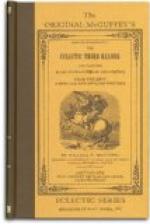The success of the McGuffey Readers was due primarily to their adaptation to the general demand of the schools and secondarily to the energy and skill of their publishers.
[Moral Teaching]
The books in their first form were strongly religious in their teaching without being denominational. If a selection taught a moral lesson this was stated in formal words at the close. The pill was not sugared. Thus at the close of a lesson narrating the results of disobedience, the three little girls assembled and “they were talking how happy it made them to keep the Fifth Commandment.” There was in the books much direct teaching of moral principles, with “thou shalt” and “thou shalt not.” In the later revisions this gradually disappeared. The moral teaching was less direct but more effective. The pupil was left to make his own deduction and the formal “haec fabula docet” was omitted. The author and the publishers were fully justified in their firm belief that the American people are a moral people and that they have a strong desire that their children be taught to become brave, patriotic, honest, self-reliant, temperate, and virtuous citizens.
In some of these books the retail price is printed. In 1844 the retail price of the First Reader was twelve and a half cents. It contained 108 pages. In the same year, the Second Reader of 216 pages was priced at 25 cents. The Fourth Reader cost 75 cents, and contained 336 pages.
These prices were in a market when the day’s wage of a laboring man was only fifty cents. Relatively to the cost of other articles, schoolbooks were not nearly so cheap as they are now.
[Copyright Files]




